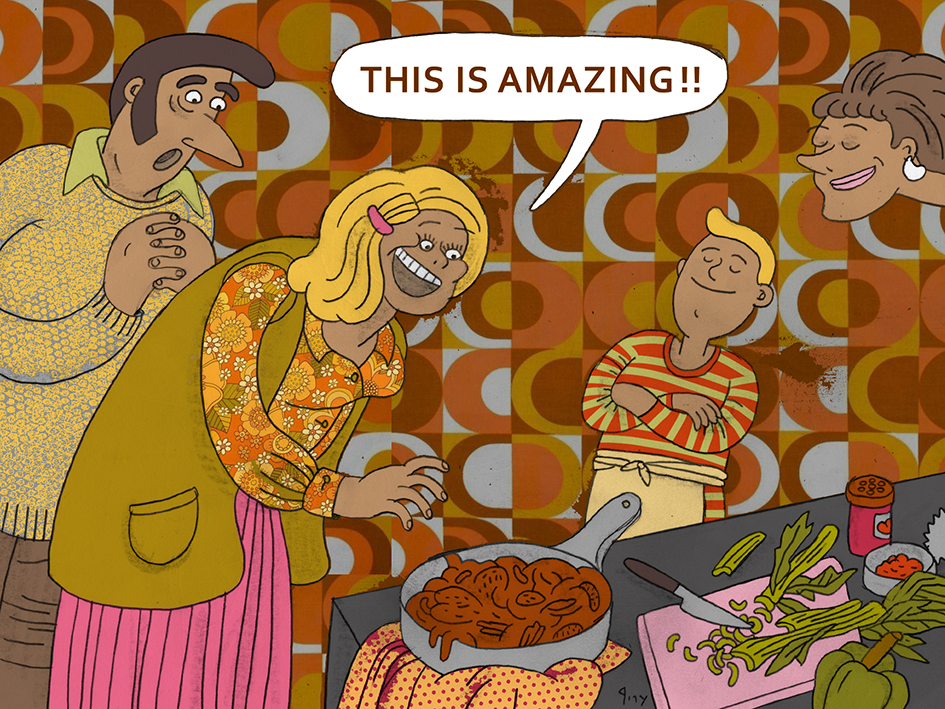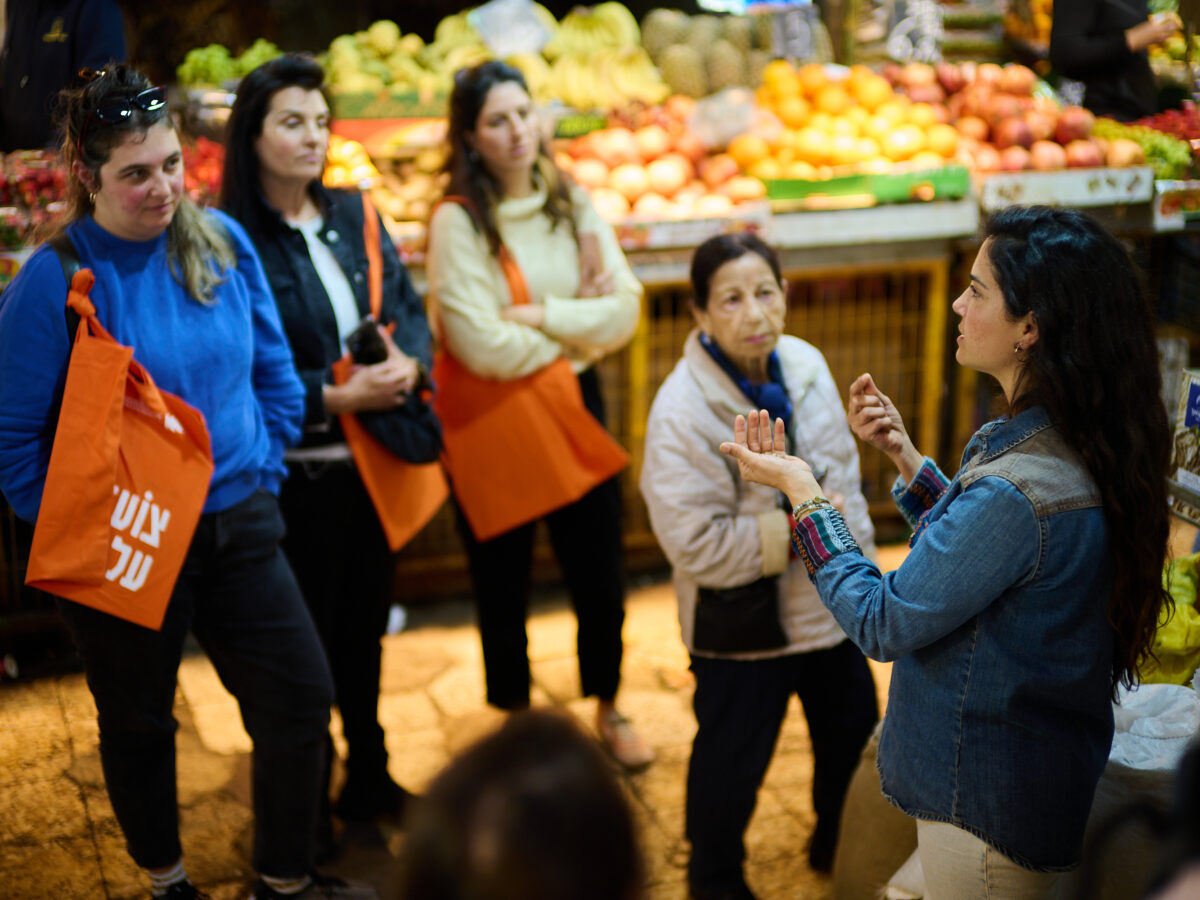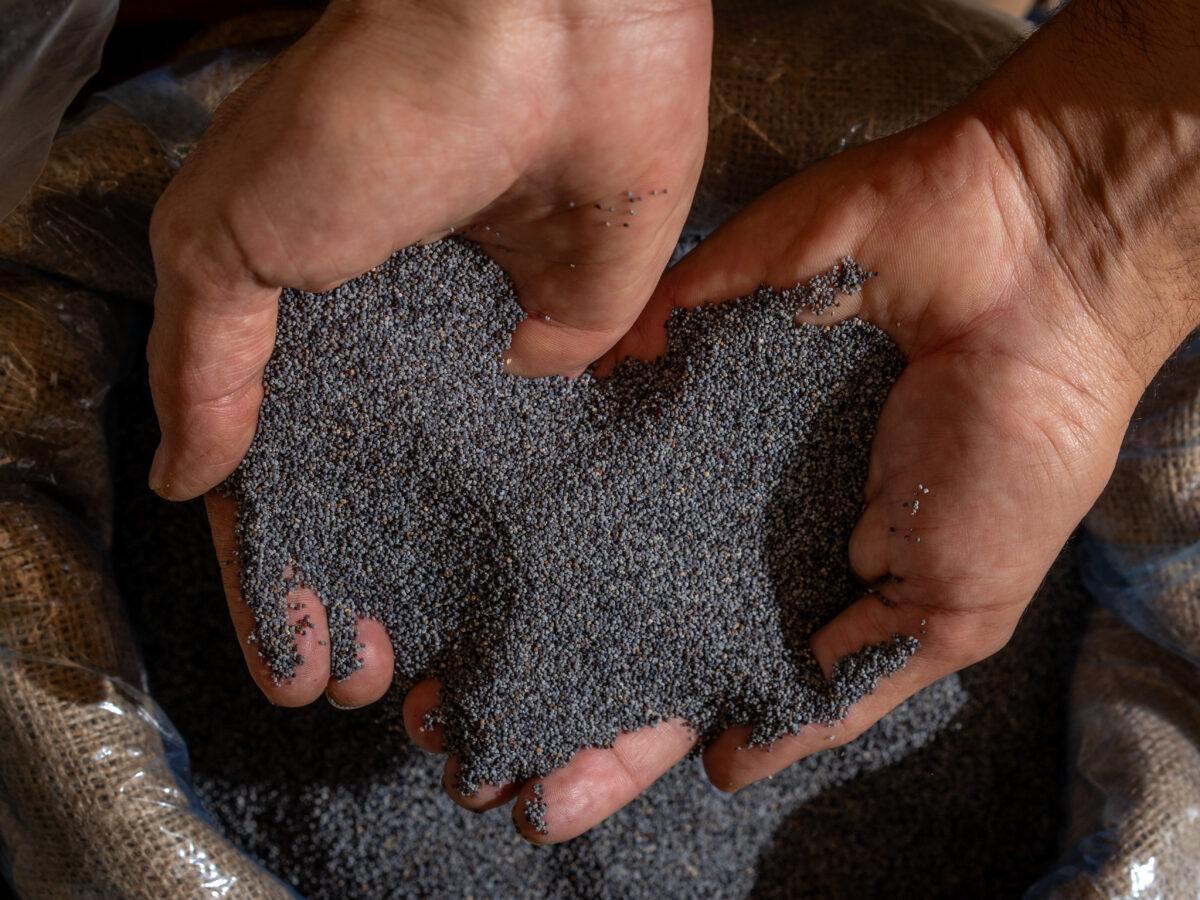“I have this book at home!” exclaims nearly every visitor to the Asif Library when they come across “Cooking With Love” by Ruth Sirkis. It’s no surprise. The book, which was published in 1975, is the most successful Israeli cookbook of all time with close to a million copies sold.
We wanted to know: What’s the secret of this cookbook? Why, after nearly half a century, when tastes and Isreali pantries have changed so much, has the book endured? We turned to four leading culinary experts, cookbook author Gil Hovav, TV and radio host Efrat Enzel, Palestinian culinary columnist Muzna Bishara, and chef Ayelet Latovitch, to share their memories of the book and how it shaped their cooking and even their worldview.
A Culinary Revolution on the Page, by Gil Hovav

Gil Hovav is a cookbook writer and TV host. He speaks around the world on food, the Hebrew language, and books.
The importance of “Cooking With Love” is primarily, but not exclusively, historical. Ruth Sirkis’s first cookbook, which is to be the first in a long series of books by her, sparked a revolution — it was the first modern cookbook published in Israel. Some cookbooks preceded it, of course, and some of them were ok, but they were cryptic, less detailed, usually slender, and usually old fashioned. Sirkis is a cook — a cook, I emphasize — not a TV chef, not a media star, not a rock star. She is a serious, hardworking, thorough cook with a great love of the kitchen — these are characteristics I greatly admire. After we fell for the magic of star chefs, I realized chefs were not supposed to be that way: it does not do them, nor the public, any good.
“Cooking With Love” was published in 1975 after Sirkis returned from spending several years in the U.S. with her husband, and she wrote her cookbook in that style — the American style. She wrote a mainstream book, in the most positive sense of the word; and yet, when the book first came out, it was like a UFO had landed at the Israeli airport. I think I was 11 years old when I got it, and it paved my way into the kitchen. I remember myself making the Mediterranean chicken dish over and over again, which may not be something to brag about these days — it calls for supermarket tomato paste and spices — but everybody kept saying: “It’s just like in a restaurant!” It was a success, and I was so proud.
Sirkis is an excellent writer, a gifted publisher, and a woman who has travelled and researched tirelessly. But, deep down she is a home cook with common sense and two feet on the ground. When she writes a recipe, she takes into account the dishes that will need washing, calculates how many people it will feed, and makes sure there are carbohydrates and proteins on the table. This is the right way to think about food when addressing home cooks, instead of pretentious plating or an insistence on molecular cooking techniques and other recent culinary embarrassments.
To put it plainly: In 1970s Israel, the idea that someone would clearly and methodically explain a recipe was unheard of. Recipes were being published, but only well-seasoned cooks could interpret them; it was a secret code. I was not a cook at the time, and suddenly I could make dishes that had never appeared on our family table before. We ate well at home, but the possibility of making new, unfamiliar dishes was exciting to me, and to many other Israelis. For the first time, recipes were presented in an alluring and precise way, which was both intelligent and not condescending to the cook. The importance of this book cannot be overstated: From it, Israelis suddenly discovered it was possible to cook dishes beyond the family repertoire — and succeed.
The First Blogger of Israel, by Efrat Enzel

Efrat Enzel is a content culinart expert, curator, and entrepreneur.
My mother is standing in the kitchen, mixing soft white cheese with onion soup powder. In a separate bowl, she combines cheese and butter with loads of paprika. She stacks a pile of crackers on the side, and it’s ready for serving. It’s the 1980s and we are witnessing a change in style.
The book that would transform Israeli hosting came out in March 1975, the month of my birth. But Israelis had no idea the impact the book would have.
We only knew that it was the first Israeli cookbook that didn’t settle for illustrations, but contained real photographs of food, and didn’t stop at recipes and instructions, but accompanied the beginner cook and introduced him (or her, as the cookbook addressed a female audience) to the art of hosting, step by step. This book did not assume we were all perfect hosts who only came searching for a dish to two to spice up our repertoire; it taught us we had the right to indulge.
Dozens of sociological articles have been written about this book, analyzing its success, trying to decipher the secret that made it the bestselling Israeli cookbook of all time. But I believe none of these articles were written in the last decade, and something happened in that time that can help explain the success of “Cooking With Love” — the rise of social networks and the blogosphere.
If we look at culinary blogs today, we see the most popular of them reveal truths about the lives of their writers. They do not hesitate to expose embarrassing moments, documenting the learning process the writer/cook went through: the trials, errors, and hesitations on the path to the perfect recipe. In one word, they show authenticity.
In her introduction, Sirkis tells her readers how she and her husband Rafi moved to Boston on a diplomatic mission, where she had no choice but to become the perfect host overnight, a woman of the world, one who knows how to set a striking buffet or serve a splendid meal with effortless elegance. She had to look around her and learn as she went. It showed her what the beginner cook needed to know to gain the confidence to host and do more than satisfy his or her guests’ hunger.
She was familiar with the different challenges of planning a meal, buying groceries, cooking, storing, and reheating, and she knew how important it was to welcome the guests happy and refreshed. She knew exactly what to write, and how didactic and detailed it should be, so that each and every cook will find the answers they are looking for.
In other words, Sirkis chose authenticity. And in slightly more daring words, I believe she was the first blogger of Israel. Only Sirkis worked in print, many years before we could even dream about the invention of the internet.
She is the most authentic and straightforward Israeli culinary writer of all time, who has paved the road for the next generation of writers. “Cooking With Love” is as modest and unpretentious a cookbook can be. It has answers for everyone and it makes everyone feel it is absolutely fine to indulge — and it is also absolutely fine if you don’t know how — because this book was written just for you.
The Gang, by Ayelet Latovitch

Ayelet Latovitch is a chef, cookbook author, and Asif’s culinary manager.
In the 1970s, once every few weeks my parents joined a group of friends they called “the gang” for a roving house party. They drank a little and ate a lot, but mostly they danced and were happy together.
Once — I was probably about six-years-old — a party was held at our place, leaving behind small pizzas. I wasn’t interested in food, but relished their flavors: the deep sweetness of tomato sauce, seasoned with dry herbs; the crunchy bread and the layer of spicy cheese melted on top.
Some time must have passed, and I must have grown up a little, because in my next memory of the gatherings, I am already taking part in preparations. I’m standing next to the bread drawer, using a glass to cut circles of soft white bread, and begging my mother to save me some pizzas this time, too. I think my parents even allowed me to stay at the party for a while, because I can still picture a punch bowl on a table in the corner of the living room, and my parents’s friends Itzik, Efi, Yehudit and Kobi — all of them cheerful. But there were no pizzas waiting for me the next day.
Only when I grew up did I manage to connect these pizzas, an onion pie served when my father invited colleagues over for Shabbat dinner, and an Italy-themed class party, to Ruth Sirkis’s “Cooking With Love.” Years went by before I realized the nut-covered cheese balls my mother insisted on preparing every Shavuot — even though no member of the extended family ever ate them — were a symbol of transition from the traditional Persian cuisine of her mother to modern food, and modern hosting, the kind that opens a window to new worlds. The book is still there, on the kitchen shelf. And yes, every Shavuot my mother still brings along the nut-coated cheese balls and sliced apples, as well as ash reshteh mastin (a traditional Persian dish of noodles, red beans, loads of fried onions and cheese, and a lot of minced mint leaves). My palate remembers the taste of these pizzas and the butter-rich onion pie. I bring them along whenever I feel the urge to create new flavors: they taught me the physical sensation of deliciousness.
Swans on the Shelf, by Muzna Bishara

Muzna Bishara is part of the Asif’s content team and the author of the column “My Palestinian Kitchen: Stories of Family & History.”
The last thing you would expect to find in an Arab kitchen in the 1980s was a cookbook. The common thinking was that a woman didn’t need a book to teach her how to prepare food for her family. She needed a grandmother, a mother and aunts; through them and their communal cooking, cooking tradition was passed on naturally, and absorbed into each cell of the body from early childhood.
In my mother’s rather traditional kitchen, things were not very different, expect for one small thing: on one of the kitchen’s shelves rested Ruth Sirkis’s cookbook, “Cooking With Love.”
In our house, this book was both a cookbook and a children’s book. My sisters and I spent hours turning its pages, fantasizing about feasts “like those in the movies:” long tables set with golden tableware and dishes served in succession, a concept which was very different and distant from the communal, crowded meals to which we were accustomed. The recipes which stuck in my mind the most were the shaped sandwiches, the cheese ball rolled in nuts, and the festive chicken jelly.
The accompanying illustrations and images intrigued us, but to our disappointment, we had to settle for fatayer and sambusak instead. My sisters and I developed a habit of looking for recipes and running to ask our mother if she could make them. We asked her over and over to make the irresistible-looking profiteroles in the shape of swans. It took our mother a long time to say yes, and our swans may have had crooked necks, too-large heads and squashed bodies, but I still remember them as one of the most delicious bites I’ve had.
From the book’s selection of dishes, some of which were very foreign to our palate, my mother adopted two recipes. The first was a rich cheesecake, which she makes to this day, with slight alterations like substituting margarine with butter and soft white cheese with cream cheese. The second recipe is a Hungarian goulash, which she passed on to all the women of the family in an Arabized version, adding beans, cardamon, allspice and root vegetables. It soon became part of my grandmother’s repertoire.
Even today, with a respectable amount of kitchen experience and a shelf full of international cookbooks, I still return to “Cooking With Love” from time to time, and prepare updated versions of its recipes. I even made the swans recently, and they turned out delicious; just like I remembered.


